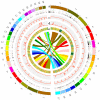Opposite Polarity Monospore Genome De Novo Sequencing and Comparative Analysis Reveal the Possible Heterothallic Life Cycle of Morchella importuna
- PMID: 30149649
- PMCID: PMC6164635
- DOI: 10.3390/ijms19092525
Opposite Polarity Monospore Genome De Novo Sequencing and Comparative Analysis Reveal the Possible Heterothallic Life Cycle of Morchella importuna
Abstract
Morchella is a popular edible fungus worldwide due to its rich nutrition and unique flavor. Many research efforts were made on the domestication and cultivation of Morchella all over the world. In recent years, the cultivation of Morchella was successfully commercialized in China. However, the biology is not well understood, which restricts the further development of the morel fungus cultivation industry. In this paper, we performed de novo sequencing and assembly of the genomes of two monospores with a different mating type (M04M24 and M04M26) isolated from the commercially cultivated strain M04. Gene annotation and comparative genome analysis were performed to study differences in CAZyme (Carbohydrate-active enzyme) enzyme content, transcription factors, duplicated sequences, structure of mating type sites, and differences at the gene and functional levels between the two monospore strains of M. importuna. Results showed that the de novo assembled haploid M04M24 and M04M26 genomes were 48.98 and 51.07 Mb, respectively. A complete fine physical map of M. importuna was obtained from genome coverage and gene completeness evaluation. A total of 10,852 and 10,902 common genes and 667 and 868 endemic genes were identified from the two monospore strains, respectively. The Gene Ontology (GO) and KAAS (KEGG Automatic Annotation Serve) enrichment analyses showed that the endemic genes performed different functions. The two monospore strains had 99.22% collinearity with each other, accompanied with certain position and rearrangement events. Analysis of complete mating-type loci revealed that the two monospore M. importuna strains contained an independent mating-type structure and remained conserved in sequence and location. The phylogenetic and divergence time of M. importuna was analyzed at the whole-genome level for the first time. The bifurcation time of morel and tuber was estimated to be 201.14 million years ago (Mya); the two monospore strains with a different mating type represented the evolution of different nuclei, and the single copy homologous genes between them were also different due to a genetic differentiation distance about 0.65 Mya. Compared with truffles, M. importuna had an extension of 28 clusters of orthologous genes (COGs) and a contraction of two COGs. The two different polar nuclei with different degrees of contraction and expansion suggested that they might have undergone different evolutionary processes. The different mating-type structures, together with the functional clustering and enrichment analysis results of the endemic genes of the two different polar nuclei, imply that M. importuna might be a heterothallic fungus and the interaction between the endemic genes may be necessary for its complete life history. Studies on the genome of M. importuna facilitate a better understanding of morel biology and evolution.
Keywords: Morchella importuna; gene expansion and contraction; heterothallism; mating type; transcriptome.
Conflict of interest statement
The authors declare no conflict of interest.
Figures




Similar articles
-
Subchromosome-Scale Nuclear and Complete Mitochondrial Genome Characteristics of Morchella crassipes.Int J Mol Sci. 2020 Jan 12;21(2):483. doi: 10.3390/ijms21020483. Int J Mol Sci. 2020. PMID: 31940908 Free PMC article.
-
Genome sequence and transcriptome profiles of pathogenic fungus Paecilomyces penicillatus reveal its interactions with edible fungus Morchella importuna.Comput Struct Biotechnol J. 2021 Apr 27;19:2607-2617. doi: 10.1016/j.csbj.2021.04.065. eCollection 2021. Comput Struct Biotechnol J. 2021. PMID: 34025947 Free PMC article.
-
Genome assembly of M. spongiola and comparative genomics of the genus Morchella provide initial insights into taxonomy and adaptive evolution.BMC Genomics. 2024 May 27;25(1):518. doi: 10.1186/s12864-024-10418-8. BMC Genomics. 2024. Retraction in: BMC Genomics. 2025 May 7;26(1):449. doi: 10.1186/s12864-025-11667-x. PMID: 38802743 Free PMC article. Retracted.
-
Mating Systems in True Morels (Morchella).Microbiol Mol Biol Rev. 2021 Aug 18;85(3):e0022020. doi: 10.1128/MMBR.00220-20. Epub 2021 Jul 28. Microbiol Mol Biol Rev. 2021. PMID: 34319143 Free PMC article. Review.
-
Artificial cultivation of true morels: current state, issues and perspectives.Crit Rev Biotechnol. 2018 Mar;38(2):259-271. doi: 10.1080/07388551.2017.1333082. Epub 2017 Jun 6. Crit Rev Biotechnol. 2018. PMID: 28585444 Review.
Cited by
-
Construction of nucleus-directed fluorescent reporter systems and its application to verification of heterokaryon formation in Morchella importuna.Front Microbiol. 2022 Nov 21;13:1051013. doi: 10.3389/fmicb.2022.1051013. eCollection 2022. Front Microbiol. 2022. PMID: 36478869 Free PMC article.
-
Whole-genome sequencing and evolutionary analysis of the wild edible mushroom, Morchella eohespera.Front Microbiol. 2024 Feb 1;14:1309703. doi: 10.3389/fmicb.2023.1309703. eCollection 2023. Front Microbiol. 2024. PMID: 38361578 Free PMC article.
-
Integration of Transcriptomics and Metabolomics for Understanding the Different Vegetative Growth in Morchella Sextelata.Front Genet. 2022 Feb 4;12:829379. doi: 10.3389/fgene.2021.829379. eCollection 2021. Front Genet. 2022. PMID: 35186020 Free PMC article.
-
Mating-Type Genes Play an Important Role in Fruiting Body Development in Morchella sextelata.J Fungi (Basel). 2022 May 25;8(6):564. doi: 10.3390/jof8060564. J Fungi (Basel). 2022. PMID: 35736047 Free PMC article.
-
Chromosome-level genome assemblies of Verpa bohemica and Verpa conica.Sci Data. 2025 May 27;12(1):880. doi: 10.1038/s41597-025-05224-0. Sci Data. 2025. PMID: 40425600 Free PMC article.
References
-
- Traeger S., Altegoer F., Freitag M., Gabaldon T., Kempken F., Kumar A., Marcet-Houben M., Pöggeler S., Stajich J.E., Nowrousian M. The Genome and Development-Dependent Transcriptomes of Pyronema confluens: A Window into Fungal Evolution. PLOS Genet. 2013;9:e1003820. doi: 10.1371/journal.pgen.1003820. - DOI - PMC - PubMed
-
- Wei L., Ya Z., Peixin H. Morel Biology and Cultivation. Jilin Science and Technology Press; Jilin, China: 2017.
-
- Ower R. Notes on the Development of the Morel Ascocarp: Morchella esculenta. Mycologia. 1982;74:142–144. doi: 10.2307/3792639. - DOI
MeSH terms
Substances
LinkOut - more resources
Full Text Sources
Other Literature Sources
Miscellaneous

